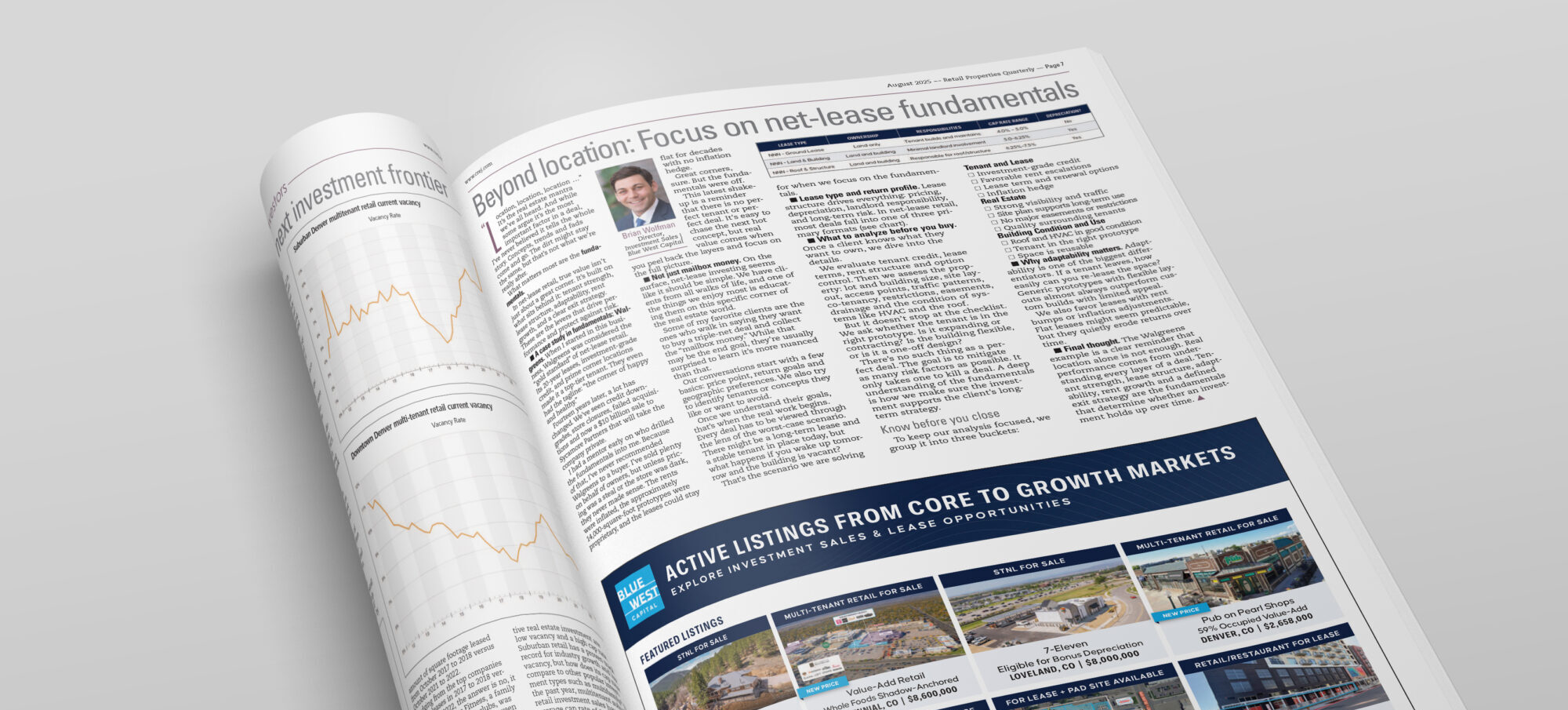written by Letty M. Bierschenk, CCIM, Kurt R. Bierschenk, CCIM, and William C. Bierschenk, CCIM, CCIM Institute
Interested Investors Should Understand the Critical Components of These Lease Structures.
Many real estate investors think nothing could be simpler than an investment in a triple-net-leased (also known as NNN) property. Some liken it to buying a bond. While straightforward to own and operate, triple-net-leased properties can be the most challenging type of real estate investment for advisers to structure or — if the lease already exists — to understand. With lease terms as long as 50 or more years when options are taken into account, due diligence is critical, as changes usually cannot be made later on.
To prevent costly mistakes during the lease term, investment advisers must completely master all critical components of the transaction early in the negotiations. These include the client’s objectives for the investment, the lease document, the type of tenant, the physical real estate, and the type of seller.
The Client’s Objective
Investors considering triple-net-leased properties usually have certain objectives in mind that might not be met by typical real estate investments. These may include relief from management obligations, assured income, pride of ownership, and preservation of capital.
Many investors seek a suitable replacement property to complete a tax-deferred exchange. Having sold a management-intensive property such as a multifamily building, they must reinvest in real estate to take advantage of the exchange provisions. They still need the income, but they no longer want a landlord’s responsibilities. In addition, many take pride in having a well-known and respected company as a tenant. Others are most interested in providing an estate for their heirs, and they prefer to have less current income with the highest possible tax deductions from interest and depreciation.
Although all of these objectives can be met through triple-net-leased investments, the variations in different triple-net-leased properties need to be considered as well.
A Lease Primer
Unlike typical commercial real estate transactions, approach the analysis of a triple-net-leased investment with the idea that it is the lease, rather than the building and land, that the investor is purchasing.
Because definitions of triple-net leases differ, be certain that you understand your client’s concept of what the lease should and should not include. You may discover that a triple-net lease does not meet the client’s objectives after all. Also, be aware that the term is widely misused in brokers’ marketing materials.
After finding a potential property, obtain a copy of the lease and analyze it first. Otherwise you can waste time and money on market studies, inspections, and contract negotiations only to find during due diligence that one paragraph in the lease knocks the property out of consideration.
Generally a net lease refers to the arrangement where the tenant pays all or some of a property’s operating costs in addition to rent. Several general gradations of net leases have evolved over the years. These are summarized here, ranked from strongest to weakest, beginning with the lease that gives the tenant absolute responsibility for the real estate in exchange for absolute control.
Bond Lease. The tenant is fully responsible for operating expenses, maintenance, repairs, and replacements for the entire building and site, without limitation.
NNN Lease. These leases follow the bond lease definition except that capital expenditures are limited, usually in the final months of the lease. The lessee is liable for all of the property’s expenses, both fixed and operating.
NN Lease. This lease follows the NNN, except the landlord is responsible for structural components, such as the roof, bearing walls, and foundation.
Modified Net (or Modified Gross) Lease. The tenant pays its own utilities, interior maintenance and repairs, and insurance. The landlord pays everything else, including real estate property taxes.
Regardless of the type of net lease, many fluctuations, such as increasing utility costs and changes in government regulations, cause problems under rigid lease terms over time. Investors must be aware of lease nuances that may seem innocuous but require knowledge and planning in order to avoid future disappointments or disasters. Two such examples are the inflation trap and the taxation burden.
The Inflation Trap. At one time, single-tenant leases were structured with flat income for 25 or 30 years, and then had a series of options at drastically reduced rent, such as 2 percent of the property’s value. The theory was that the loan would be paid off by then, so the landlord’s spendable income would not be reduced. But inflation made this a nightmare for owners. When income was compared to current rent schedules, properties only could be sold at tremendous price reductions.
Today new leases take this possibility into account by specifying periodic rent increases, with options, if any, pegged to "fair market rent" or other indicators that preserve the income level.
Taxation Burden. Local laws and customs also may affect leases. For example, because triple-net tenants are responsible for real estate taxes, including any future increases, a unique situation developed in California with "Proposition 13" in 1978. It established a new base tax amount of 1 percent of the then value and limited tax increases to 2 percent each year until the property sold. Upon sale, taxes would be recalculated to 1 percent of the new purchase price. This formula, combined with soaring real estate values, meant that tenants were faced with wild leaps in rental rates due solely to changes of ownership, which in no way benefited the tenant.
Today tenants and landlords still are hamstrung over this issue. Tenants generally agree to an allowance for pass-throughs of increases except in the event of a sale. Owners reject these lease provisions, correctly noting that the impact on the net income to a future buyer results in a reduced market value of the real estate.
Triple-Net Tenants
After mastering the lease, the next factor to evaluate is the tenant.
Credit Worthiness. From an investor’s perspective, a triple-net-leased property’s price should reflect the tenant’s ability to meet the terms of the lease. The capitalization rate indicates this variable risk factor, because it directly represents the relationship of the stipulated net income to the price a knowledgeable investor is willing to pay. The higher the risk that a tenant may not be solvent over the long term, the higher the cap rate should be.
A tremendous amount of information is available to assist in evaluating the current and future financial strength of a tenant. If it is a public company, the credit rating is fairly easy to determine through a number of sources, including sites available on the Internet such as http://www.companysleuth.com/, http://www.zacks.com/, and http://www.freeedgar.com/.
The trend toward mergers and divestments adds another dimension to credit reviews. Even though the resulting entity usually is stronger than the original company, the risk of the unknown can be perceived as a negative factor.
If the business is complex or privately held, contact a fee-based tenant underwriting service for added assistance.
Type of Use. Even if the credit rating is substantial, the type of business may affect investment value. From an investment standpoint, a general-purpose use, where tenant improvements easily are convertible to another tenant’s needs, is more desirable than a special-use project. In many special-use cases, the seller passes along the costs of highly specialized improvements to the buyer, who may be unable to recover that portion of the investment over the lease term. Fast-food outlets are a prime example of this problem, but certainly not the only one.
The Physical Real Estate
After reviewing the lease and tenant/landlord compatibility, investors then should evaluate the physical real estate. All categories of office, industrial, retail, multifamily, and hotel properties, and even undeveloped land, can be sold on a triple-net-lease basis, without regard for size, design, or location. However, retail, office, and industrial most often are available in the marketplace.
Businesses that typically lease rather than own their real estate are those that achieve a business-income yield that is substantially higher than the typical real estate yield of 8 percent to 10 percent pre-tax. High-volume retail operations are probably most prevalent. But each investment must be considered individually. For instance, if an investor purchases a special-purpose building with a "theme" construction, the net worth of the company is of prime importance. On the other hand, a food market in a good neighborhood shopping center most likely can withstand even a change of tenancy without significant loss of income.
Similarly, industrial buildings can be classified as warehouse, manufacturing, or research and development space. They come with and without substantial office space and range in size from 10,000 square feet to 500,000 sf. Even warehouse space can be highly specialized today, including high-cube to accommodate the new storage technology, or dock-high local storage for lower volume distribution.
Manufacturing facilities usually have the greatest number of special-purpose characteristics, such as drainage wells, overhead cranes, two-foot-thick concrete floors, and special lighting and exhaust systems that preclude their use by other businesses. The possibility of hazardous materials in any manufacturing process may require consultation with experts who can advise on ways to minimize the landlord’s liability for adverse consequences.
Office buildings, even though they come in all sizes and styles — from free-standing, one-room buildings to lush garden complexes to high-rise palatial headquarters — are easiest to evaluate because they are the most closely tied to location as an indicator.
The purchase price should take into account replacement costs and comparable sales, but be wary of an overmarket rent that cannot be achieved with another tenant in the future. Inflated rents may make the investment return appear desirable. However, if market rents and prices of comparable buildings in the area are substantially lower, the resale value may be less than what the investor paid for the property and the actual yield probably will be lower than other alternative opportunities in the marketplace.
Analyze the effect of overmarket rents on investments by generating a range of internal rate of return calculations, incorporating these assumptions that might impact resale values:
- The tenant renews at a consistent rental rate in the year of sale.
- The property must be released at projected market rent in the year of sale for the same type of use.
- The property must be released for a different use.
Comparing these IRRs demonstrates the marginal value attributed to the current tenant, over and above the demonstrated investment value. Whether or not it is in line with reality can be a subjective call based largely on a client’s "feel" for the company. Quite often, buyers will ignore the importance of the type and location of the real estate when evaluating a triple-net investment. It is not unusual for a fast-food facility to sell at four or five times the replacement value, because the investor is satisfied with the projected return based on the tenant’s strength and length of the lease. But brokers must educate buyers as to the potential problems if such tenants were to go out of business.
Furthermore, if the triple-net facility is located in a shopping center, the owner also must consider the effect of a possible failure of the business location, even if the tenant "goes dark" but continues to pay rent. The loss of traffic, which the credit tenant might have drawn, can impact the sales volumes of every other tenant in the center and destroy the synergism of a previously well-constructed retail mix.
Triple-Net Sellers
Triple-net-leased property sellers fall into three categories: investor/owners of leased properties; owner/users creating sale/leasebacks; and build-to-suit developers.
Investor/Owner. This type of seller presents a known entity for an investor’s analysis. The lease may be a true triple net but with a short remaining primary lease term, requiring either re-leasing or a series of short-term options. Investors can evaluate base rent and expense payment history and may have access to historical sales volumes to assist in determining the likelihood of future income.
Even after the prospective purchaser has analyzed and approved the lease, stipulate a review of an estoppel as a contingency of closing. Many sellers only are willing to involve a tenant during the final stages of the transaction, when they are assured of a sale. However consider what may happen if the estoppel comes back a week before closing and it differs in some way from what the seller’s documents had shown, or worse yet, presents an addendum granting a first right of refusal to purchase the property. Have a clear understanding as to when the seller is willing to submit the form, take note of the response time agreed to by the tenant in the lease, and build this into your contingency timeline.
Owner/User. The triple-net lease is well suited to sale/leasebacks as a way to transition the selling company from having absolute control over its surroundings to a situation where it merely is a "lessee." Despite the emotional response that may be generated by the change in status, the sale/leaseback provides a number of advantages to both seller and buyer. The seller frees up capital, often 100 percent of the equity in the real estate, to expand or enhance the business. Since a business return, generally speaking, is higher than the typical 8 percent to 10 percent real estate return, the seller can benefit from the lower cost of investment capital.
Sellers and buyers also benefit by being able to customize a transaction, negotiating sale and lease terms that reflect unique landlord and tenant needs. Investors, for example, may agree to a higher purchase price in exchange for stipulated rent increases, rather than taking the risk of cost-of-living increases. They may trade a short initial term for a series of 10-year rather than five-year options. Tenants may feel comfortable with the obligations of a bond-type lease because they know the property.
One potential negative is the possibility that the seller overimproved the physical plant to enhance the company’s image and expects the buyer to cover overmarket amenities. This occurs most often with office buildings, but overimproved industrial facilities can be even more difficult to evaluate since the perception of overimprovement is related to the location as well as to the building itself.
Developer. From a logistics standpoint, developers are relatively straightforward, since they are professionals who will have the information you need readily available. As always, consider the seller’s motivations. The developer’s first objective is to build. With a lease in hand, the developer can get construction financing and create the product. The second objective is to sell at a profit, so it is necessary to build a return into the transaction. However, the developer’s costs may be relatively low because of economies of scale in creating a large amount of product. One of the benefits is that the lease is already drawn, and a meticulous analysis of the terms virtually can eliminate the chance of contractual surprises during your client’s ownership.
The main potential downside is that there is no performance history for the site. Second, even experienced developers sometimes give in to a strong tenant’s demands, even though the terms may be detrimental to the property’s investment value.
Armchair Investments
Carefully structured and underwritten, a triple-net-leased real estate investment can be an armchair type of investment. However, before an investor commits capital to such a long-term investment vehicle, pre-acquisition due diligence is paramount. Real estate advisers must ascertain the degree to which the lease is, in fact, a triple-net, the likelihood that the tenant will succeed, and the suitability of the real estate itself for the proposed and subsequent use. Finally, match all of these components to the unique characteristics and goals of the investor to determine if this type of property is a right fit.
Be the first to know about new investment properties.
Subscribe to our mailing list






